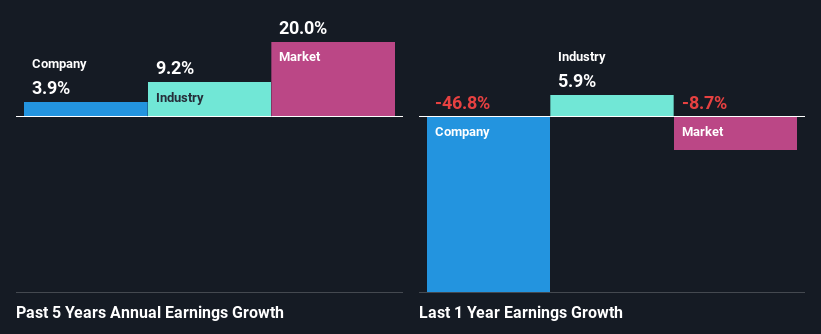Stock Analysis
- Canada
- /
- Food and Staples Retail
- /
- TSXV:RUM
Rocky Mountain Liquor Inc.'s (CVE:RUM) Stock is Soaring But Financials Seem Inconsistent: Will The Uptrend Continue?

Rocky Mountain Liquor (CVE:RUM) has had a great run on the share market with its stock up by a significant 100% over the last three months. But the company's key financial indicators appear to be differing across the board and that makes us question whether or not the company's current share price momentum can be maintained. Particularly, we will be paying attention to Rocky Mountain Liquor's ROE today.
Return on Equity or ROE is a test of how effectively a company is growing its value and managing investors’ money. In short, ROE shows the profit each dollar generates with respect to its shareholder investments.
View our latest analysis for Rocky Mountain Liquor
How To Calculate Return On Equity?
Return on equity can be calculated by using the formula:
Return on Equity = Net Profit (from continuing operations) ÷ Shareholders' Equity
So, based on the above formula, the ROE for Rocky Mountain Liquor is:
3.1% = CA$273k ÷ CA$8.8m (Based on the trailing twelve months to September 2023).
The 'return' is the yearly profit. Another way to think of that is that for every CA$1 worth of equity, the company was able to earn CA$0.03 in profit.
What Is The Relationship Between ROE And Earnings Growth?
We have already established that ROE serves as an efficient profit-generating gauge for a company's future earnings. Depending on how much of these profits the company reinvests or "retains", and how effectively it does so, we are then able to assess a company’s earnings growth potential. Generally speaking, other things being equal, firms with a high return on equity and profit retention, have a higher growth rate than firms that don’t share these attributes.
Rocky Mountain Liquor's Earnings Growth And 3.1% ROE
It is quite clear that Rocky Mountain Liquor's ROE is rather low. Not just that, even compared to the industry average of 14%, the company's ROE is entirely unremarkable. Thus, the low net income growth of 3.9% seen by Rocky Mountain Liquor over the past five years could probably be the result of it having a lower ROE.
We then compared Rocky Mountain Liquor's net income growth with the industry and found that the company's growth figure is lower than the average industry growth rate of 9.2% in the same 5-year period, which is a bit concerning.

Earnings growth is an important metric to consider when valuing a stock. It’s important for an investor to know whether the market has priced in the company's expected earnings growth (or decline). By doing so, they will have an idea if the stock is headed into clear blue waters or if swampy waters await. Is Rocky Mountain Liquor fairly valued compared to other companies? These 3 valuation measures might help you decide.
Is Rocky Mountain Liquor Efficiently Re-investing Its Profits?
Rocky Mountain Liquor doesn't pay any regular dividends currently which essentially means that it has been reinvesting all of its profits into the business. However, this doesn't explain the low earnings growth the company has seen. So there might be other factors at play here which could potentially be hampering growth. For example, the business has faced some headwinds.
Summary
On the whole, we feel that the performance shown by Rocky Mountain Liquor can be open to many interpretations. Even though it appears to be retaining most of its profits, given the low ROE, investors may not be benefitting from all that reinvestment after all. The low earnings growth suggests our theory correct. Wrapping up, we would proceed with caution with this company and one way of doing that would be to look at the risk profile of the business. To know the 2 risks we have identified for Rocky Mountain Liquor visit our risks dashboard for free.
Valuation is complex, but we're helping make it simple.
Find out whether Rocky Mountain Liquor is potentially over or undervalued by checking out our comprehensive analysis, which includes fair value estimates, risks and warnings, dividends, insider transactions and financial health.
View the Free AnalysisHave feedback on this article? Concerned about the content? Get in touch with us directly. Alternatively, email editorial-team (at) simplywallst.com.
This article by Simply Wall St is general in nature. We provide commentary based on historical data and analyst forecasts only using an unbiased methodology and our articles are not intended to be financial advice. It does not constitute a recommendation to buy or sell any stock, and does not take account of your objectives, or your financial situation. We aim to bring you long-term focused analysis driven by fundamental data. Note that our analysis may not factor in the latest price-sensitive company announcements or qualitative material. Simply Wall St has no position in any stocks mentioned.
About TSXV:RUM
Rocky Mountain Liquor
Rocky Mountain Liquor Inc., through its subsidiary, Andersons Liquor Inc., owns and operates liquor stores in Canada.
Solid track record with adequate balance sheet.

